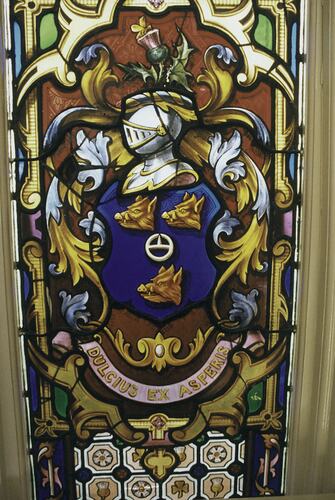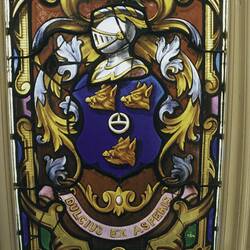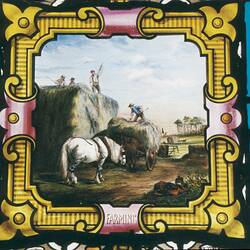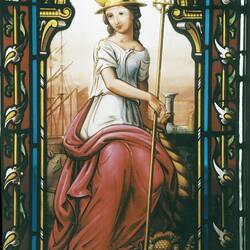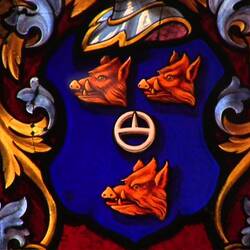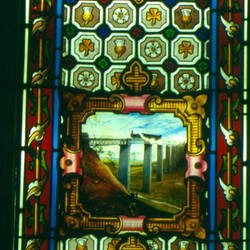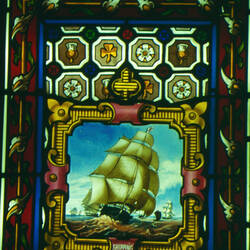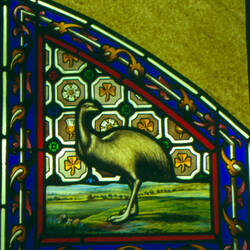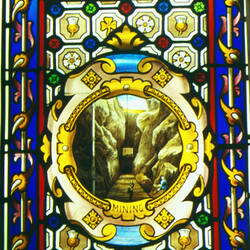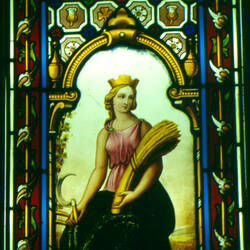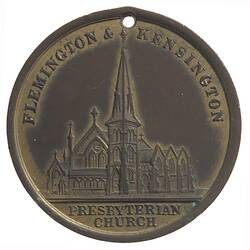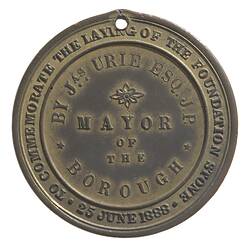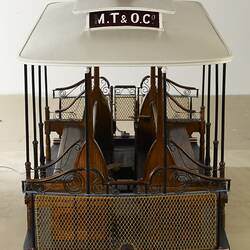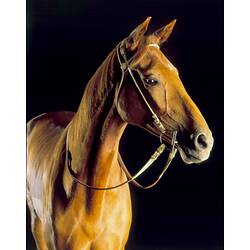Summary
Stained glass window made for 'Glenferrie', Malvern, the residence of James Fergusson, a Melbourne manufacturing stationer and member of the Legislative Assembly, and Shire President 1871-72.
'Glenferrie' was a two-storey mansion with fourteen rooms and extensive grounds. Its land extended from Glenferrie Rd and Toorak Rds to the far side of the railway line. In 1903 the estate was subdivided, and the house was called Zeerust by a subsequent owner.
The style of the window strongly indicates it was locally made by Ferguson & Urie, the main stained-glass manufacturers in Melbourne from the early 1860s to the 1890s. Following the demolition of Glenferrie in 1954, the window was purchased by a local resident, and subsequently installed in a modern home in the 1970s in Mernda Road, Kooyong.
Physical Description
A large leaded and stained glass window, 3.5 metres by 2 metres, attributed to Melbourne stained glass manufacturers Ferguson and Urie; dated c. 1872. Three tall panels, with three small panels above, which show a kangaroo and emu on either side of an early Australian coat of arms. Pride of place in the liddle window is given to the Fergusson Blazon of Arms, with three boars heads and a buckle. There are six hand-painted vignettes showing aspects of Victorian industry: shipping, farming, pastoral, printing, mining and railways. There are two female figures representing Agriculture and Commerce. Images of thistles, roses and the shamrock represent respectively Scotland, England and Ireland. All panels are bordered by a climbing floral pattern which is entwined around a gold covered rod.
Significance
Statement of Signficance:
This large stairwell window celebrates James Fergusson's success, and also reflects the confidence of ageneration of immigrants that had made their fortunes through agriculture, mining, manufacturing and trade in the young colony.
The window contains many graphic references to the British-Australian connection that underpinned Victorian society in the nineteenth century. It depicts aspects of prosperous Australian life before Federation, and celebrates aspects of Australian life and industry, albeit in a stylised English form. The window illustrates the mixed patriotism of Victorian Britons in a particularly graphic way. The window's Australian motifs, and its connection with a pioneer in the print industry, increase its significance.
The window is also significant as an example of the work of Ferguson & Urie, the major stained glass designers and makers in Melbourne in the final decades of the 19th century.
More Information
-
Collecting Areas
-
Acquisition Information
Cultural Gifts Donation from Mr Richard Price, 25 Sep 2001
-
Acknowledgement
Donated through the Australian Government's Cultural Gifts Program.
-
Maker
Ferguson & Urie, Melbourne, Greater Melbourne, Victoria, Australia, 1872
-
Original Owner
Mr James Fergusson, 'Glenferrie', Malvern, Greater Melbourne, Victoria, Australia, 1872-1888
-
Place & Date Used
-
Place & Date Used
5 Mernda Road, Kooyong, Greater Melbourne, Victoria, Australia, 1970s-2001
-
Inscriptions
'Agriculture'; 'Farming'; 'Pastoral'; 'Mining'; 'Printing'; 'Commerce'; 'Shipping'; 'Railways';
-
Classification
-
Category
-
Discipline
-
Type of item
-
overall dimensions
191 cm (Length), 18.5 cm (Width), 334 cm (Height)
-
Exhibition Collection Management
1910 mm (Length), 1850 mm (Width), 3340 mm (Height)
-
Dimensions
1.9 m (Width), 3.3 m (Height)
Measurement From Conservation.
-
References
File correspondence in Supp. File suggests that the window may not be by Ferguson & Urie, but by someone who was influenced by their style.
-
Keywords
